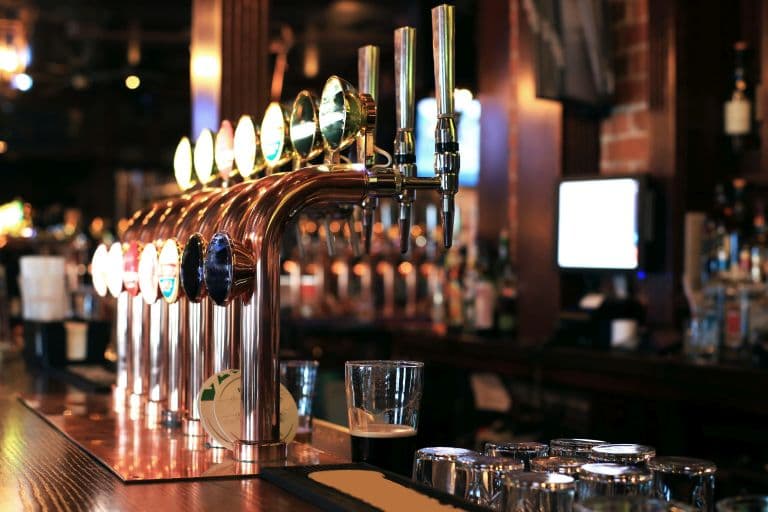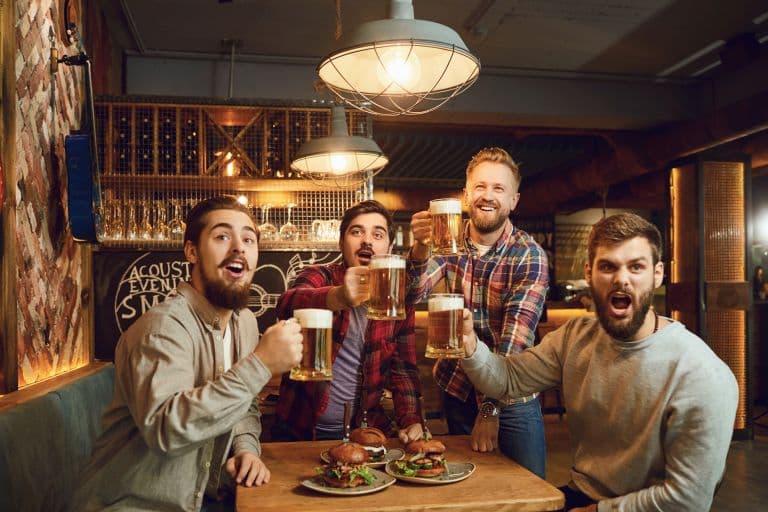If it’s a Friday night and you’re up for a bit of a drink, maybe some food, and even thinking you might be able to pick up some stank on the hang-low, as Socrates used to put it, you’ll probably end up in a pub or a bar, or several.
But while both of these places offer the potential for a boozy mating ritual, there’s a stark contrast in their approach.
So, what really is the difference between a Bar and a Pub?
Let’s take a look at how these drinking establishments vary in atmosphere, offerings, and tradition.

The TL;DR
Bars typically focus more on providing a liquid buffet: various types of drinks, often different colours, sometimes on fire, and are more geared towards serving lots of people who enjoy not being able to hear one another talk.
Pubs, or “public houses” offer more of a homely atmosphere, usually more traditional food and can be hundreds of years old with ghosts.
Read on for the detail.
The Difference Between a Bar and a Pub
If you’re on the high street on a night out and you fancy a bit of tapas and cocktails, chances are you’re looking for a bar.
Bars are usually rather dark places with one or more themes – this could be tapas and cocktails or live blues and bourbon. It could also be a student bar with discounted Redbull and shots, complete with crying teenagers sitting on the curb outside.
While they do exist, good pubs on the high street aren’t as common and will more often serve warm, watery piss like Carlsberg and be pocked with incomprehensible Irishmen. Good pubs are typically 500 years old, made of rocks, and are about three hours’ walk from the nearest settlement in the middle of the countryside.
Real pubs serve real beer, real food, and may or may not have a theme but all are legally required to have at least one of those long brass horns hanging on the wall. They’re usually called The Plough and will have various Victorian farming equipment dotted about the place.
To hone in on the differences and similarities, let’s look at each of them in turn.
What Is a Bar?
At its most fundamental and pedantic, a bar is the physical platform over which drinks are served and behind which drinks sit alluringly on glass shelves. So, the establishment of a bar is one that focuses primarily on this feature.

Bars therefore provide a wide range of drinks and a specific vibe that draws a target demographic in. Since bars are relatively simple businesses, there can be a lot of competition so niches get carved out by providing a unique blend of drinks, music and food, as well as specific lighting, a dance floor, a karaoke platform, and the like.
Food isn’t a given at a bar, though salty snacks that make people thirsty are just common sense. What’s important is the vibe. Bars can be premium mating grounds for the most virile demographics so targeting like-minded and reproductive individuals is the key. Nightclubs are essentially very noisy, dark bars that happen while everyone over 30 is trying to sleep.
Conversely, there are also bars for those of us with nothing left to live for. Dive bars combine excessive drinking with a sense of wanton desperation and American rock music, and can be a cathartic way to spend a couple of years after a nice breakup.
Sports bars are also a popular variety, designed for people who prefer watching strangers repetitively kick, hit or throw things in other countries over getting laid or dancing.
What Is a Pub?
Pubs are supposedly a Roman invention, which they brought all the way up to Roman Britain in the 40s (Note: there’s no apostrophe there because it was just the year 40).

Anyway, the resident Anglo-Saxons managed to get a whole rebellion started and sent a glorious ginger woman called Boudica to set fire to everything but it wasn’t enough! The Romans persisted and infested the hapless locals with aqueducts, sanitation, roads, wine, fermentation, canals, public health baths, cheese, medicine, irrigation, law, education, and – pubs.
Short for “Public house”, pubs remain a central point for communities of people who were once sparsely populated over the country and would gather together to drink and discover DNA and plot treason.
Real pubs have low ceilings made of reclaimed railway sleepers, serve venison and good wine, and have a range of local ales of varying quality and cloudiness. As such, they’re hardly found in the New World at all and are usually replicas.
City pubs do exist but they’re only good if the building they’re in is older than Germany and the staff don’t play their young people music too loudly.
Because of their origins, and because the rest of Europe invested in proper infrastructure for their citizens, most pubs are found in Britain and Ireland, where people with no central heating can gather around a fireplace and keep warm in the winter.
And it’s this climate of shared misery that is the essence of the difference between a pub and a bar.
Summary
Bars and pubs both serve to bring drunk people together, but there are stark contrasts in the way they approach it, most of the time.
Pubs tend to offer a remote yet homely atmosphere, mysterious fermented beverages, home-cooked food and pre-industrial artefacts. Bars focus more on the range and colour of the drinks and may come up with an interesting and unique theme to compete with the bars on either side of them.
However, in the city at least, there’s plenty of overlap: all pubs by their nature have bars in them, and some use this to provide more of a vibrant nightlife experience after work while keeping ample seating for the day drinkers and people who want a big plate for lunch. Likewise, some bars also serve decent food and music.
But to isolate the extreme ends of the spectrum, bars are loud, hot, colourful places with bartenders called Stephen; pubs are ancient, haunted, and are full of hobbits sitting around an open fire and drinking merrily from tankards.